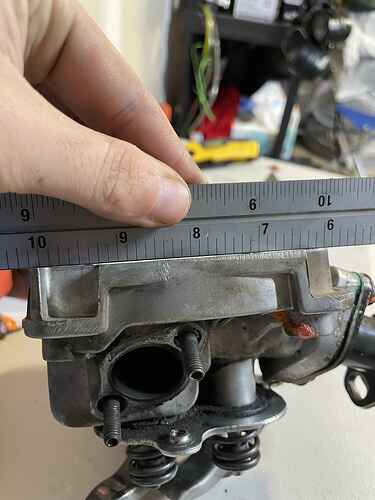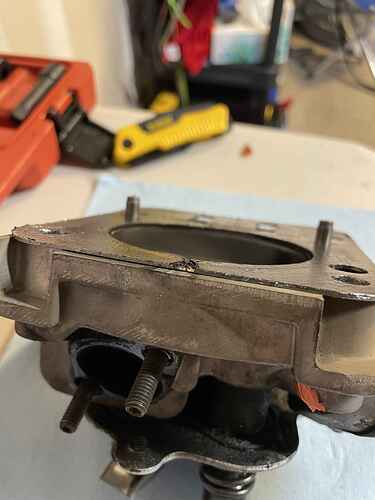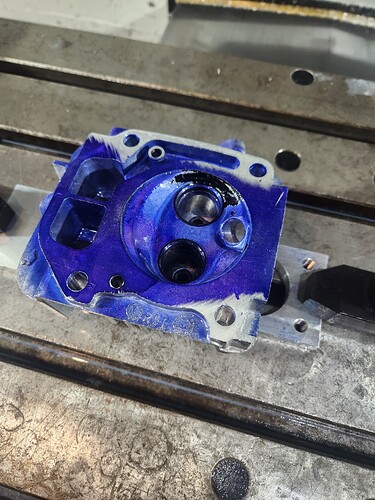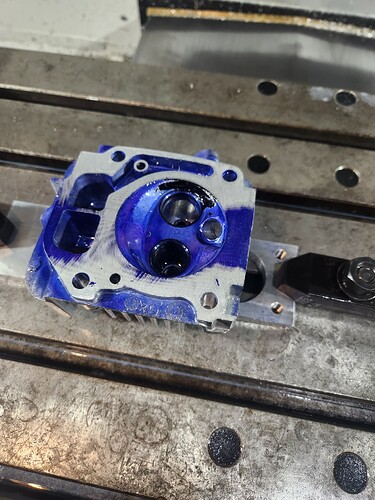Arguing with your wife is a lot like racing a Briggs. If it’s head gasket is blown, its not worth the struggle.
I’ve always torqued to 180, that’s what my old engine builder did and always worked well for us.
Pulled the head and wow…I was not expecting it to be so warped. Here is a straight edge laid across the top two bolt holes. The sag in the middle is very noticeable!
Also here is what my head gasket looked like:
Hey, that head gasket is blown… ![]()
Let us know how the truing up works for you.
Kinda impressive it sealed at all!
That’s the most aggressive head blowing i’ve seen. All i’ve seen just show the marks on the block but the gasket typically looks fine.
Side note though, i’ve had worse and you can definitely true that up no problem
Is that amount of warping actually trueable while staying within the rules? The Briggs rules state that the head must have a minimum thickness of 2.431". Up above, you said that heads are usually within .001" - .002" of that spec. While I don’t have an accurate way to measure that warpage, it looks to be more than a few thousands of an inch. I’d eyeball it around 1/16" - 1/8". Plus, the bottom half of the head gasket surface appears to be true. If I went the sanding direction, I’d have to remove a lot of material in order to get it back to flat.
Honestly, this weekend is the last race of the season. I think I am just going to throw in a fresh head gasket and run it. It lasted a race weekend before blowing last time. Then, over the winter I will just pick up a new head. I really don’t want to mess around with any modifications which could get me DSQ’d or questioned of cheating.
Once I have a new head, I might then try to see if I could true this head up using the sanding method while taking photos along the way of the process.
The material that gets removes is primarily on the edge by the bolt hole. When you true it up it’s very easy to see where material is being removed from and you can stop at any time.
If you’re not willing to I’d go high on head torque. My favorite has been 180 in-lbs Plus 10 Deg. Just dont go too crazy because you can deform the head bolts and ultimately have less clamping force in the joint
The marks on the ruler are 1/8". I think the gap is probably less than 0.010" i.e. 1/4 the thickness of the head gasket. Because if it was more, the gasket wouldn’t seal the two faces.
Piling on to the right about the head screw torque - I wonder if torqueing the bolts that are in the gap area first would help flatten the area and this reduce the gap.
I torqued them all down evenly to 200 in-lbs for now. After it heat cycles for the first time, I am going to re-torque the head bolts and may slightly bias the top two bolts to a slightly higher torque value.
We had to, and were lucky enough to borrow someone’s practice engine for a race (Stripped head bolt) and set a faster quali time than the owner on his race engine. ![]()
Good in theory, but you wont be able to get to al the head bolts without pulling the pipe and sheild
If you take off the front header support you can pull the shield off without removing the pipe. You have to wrangle it a bit but works just fine. I tried it out last night when I was strategizing for this weekend. Should be able to replace the head gasket by just removing the front header support and unplugging the spark plug.
Little update after last weekend’s race. Head gasket stayed intact! Managed to run two practice sessions, two heat races and a final without blowing it again. Rechecked the head bolts and valve lash after the first heat cycle. The bottom two head bolts loosened up a bit and the valve lash tightened (probably due to the gasket compressing). Tightened up the head bolts, reset the valve lash and ran it the rest of the day without issue. There is still compression and TDC is still easy to find.
Happy that it worked out! I’m planning on replacing the head over the winter. Once I have a new head, I may try to true up this head and see if it remains in spec for me to keep it as a backup.
A little follow-up you guys may find interesting. I pulled the head on my son’s practice engine to do a valve job. Found some minor knicks in the gasket surface, so i decided to true it up since its just his practice engine. Ended up taking 0.006" off the face to get it to clean up. I set it on my surface plate and checked the overall height compared to a gage block stack and I’m 0.004" above minimum, then depth mic’d the 2 spots called out in the rules and i am 0.003" above minimum there as well. So I guess we’re still useable!
Interesting stuff. I know nothing about these motors, but 0.006” seems like a lot to have to take off. Are all of the top-level motors being machined down to the limit at the time of being built?

The answer to your question is “No”. Not all builders are machining heads and decks. But if your question is “are SOME builders machining heads and decks?” the answer is yes…
Search on FB for this years CKNA Spring Nats drama…
I haven’t had any new heads come through that had any room for material removal to still be legal.
I was fully expecting this one to be illegal after cutting it, which i was fine with since its off a practice engine. Quite surprised there is still material there.






